Integrating Sediment (dis)Connectivity into a Sediment Yield Model for Semi-Arid Catchments
Abstract
1. Introduction
2. Sediment Processes in Semi-Arid Areas
3. Model Design Criteria
4. Conceptual Basis of the Model
4.1. Runoff Modelling and Catchment Zones
4.2. Estimating Erosion
4.3. Sediment Routing
4.4. Representing (dis)Connectivity
5. The Study Catchment
Data Preparation
6. Results
6.1. Surface Flow Distribution and Connectivity
6.2. Sediment Yield Estimates and Scenario Testing
7. Discussion
7.1. Extent to Which the Model Was Successful
7.2. Likely Source of Error
7.3. Comparison with Other Models
7.4. Model Applicability
8. Conclusions
Author Contributions
Funding
Data Availability Statement
Conflicts of Interest
Appendix A
Appendix B
References
- Newcombe, C.P.; Macdonald, D.D. Effects of Suspended Sediments on Aquatic Ecosystems. N. Am. J. Fish. Manag. 1991, 11, 72–82. [Google Scholar] [CrossRef]
- Lal, R. Soil erosion impact on agronomic productivity and environmental quality. Crit. Rev. Plant Sci. 1998, 17, 319–464. [Google Scholar] [CrossRef]
- Ananda, J.; Herath, G. Soil erosion in developing countries: A socio-economic appraisal. J. Environ. Manag. 2003, 68, 343–353. [Google Scholar] [CrossRef]
- Montgomery, D.R. Soil erosion and agricultural sustainability. Proc. Natl. Acad. Sci. USA 2007, 104, 13268–13272. [Google Scholar] [CrossRef]
- Walling, D.E. The Impact of Global Change on Erosion and Sediment Transport by Rivers: Current Progress and Future Challenges; UNESCO: Paris, France, 2009. [Google Scholar]
- Morris, G.L. Classification of Management Alternatives to Combat Reservoir Sedimentation. Water 2020, 12, 861. [Google Scholar] [CrossRef]
- Kastridis, A.; Kamperidou, V. Influence of land use changes on alleviation of Volvi Lake wetland (North Greece). Soil Water Res. 2016, 10, 121–129. [Google Scholar] [CrossRef]
- Maina, C.W.; Sang, J.K.; Raude, J.M.; Mutua, B.M.; Moriasi, D.N. Sediment distribution and accumulation in Lake Naivasha, Kenya over the past 50 years. Lakes Reserv. Res. Manag. 2019, 24, 162–172. [Google Scholar] [CrossRef]
- Vásquez-Méndez, R.; Ventura-Ramos, E.; Oleschko, K.; Hernández-Sandoval, L.; Angel, M. Soil Erosion Processes in Semiarid Areas: The Importance of Native Vegetation. In Soil Erosion Studies; IntechOpen: London, UK, 2011. [Google Scholar]
- Merritt, W.; Letcher, R.; Jakeman, A. A review of erosion and sediment transport models. Environ. Model. Softw. 2003, 18, 761–799. [Google Scholar] [CrossRef]
- Vanmaercke, M.; Poesen, J.; Broeckx, J.; Nyssen, J. Sediment yield in Africa. Earth-Sci. Rev. 2014, 136, 350–368. [Google Scholar] [CrossRef]
- Robinson, A.R. The relationship between soil erosion and sediment delivery. In Proceedings of the Paris Sym-Posium on Erosion and Solid Matter Transport in Inland Waters; IAHS: Orlando, FL, USA, 1977; pp. 159–167. [Google Scholar]
- Wolman, M.G. Changing needs and opportunities in the sediment field. Water Resour. Res. 1977, 13, 50–54. [Google Scholar] [CrossRef]
- Meade, R.H. Sources, Sinks, and Storage of River Sediment in the Atlantic Drainage of the United States. J. Geol. 1982, 90, 235–252. [Google Scholar] [CrossRef]
- Walling, D. The sediment delivery problem. J. Hydrol. 1983, 65, 209–237. [Google Scholar] [CrossRef]
- Neitsch, S.L.; Arnold, J.G.; Kiniry, J.R.; Williams, J.R. Soil and Water Assessment Tool Theoretical Documentation; Agricultural Research Service: Temple, TX, USA, 2005. [Google Scholar]
- Schulze, R.E. ACRU: Background Concepts and Theory. In ACRU Report No. 36; Depterment Agricultural Engineering, University of Natal: Pietermaritzburg, South Africa, 1989. [Google Scholar]
- Fryirs, K.A.; Brierley, G.J. Geomorphic Analysis of River Systems: An Approach to Reading the Landscape; Wiley: Hoboken, NJ, USA, 2012; pp. 1–8. [Google Scholar]
- Schumm, S.A. The Fluvial System; Wiley: New York, NY, USA, 1977. [Google Scholar]
- Lal, R. Soil degradation by erosion. Land Degrad. Dev. 2001, 12, 519–539. [Google Scholar] [CrossRef]
- Beven, K. Rainfall-Runoff Modelling: The Primer; John Wiley & Sons: Chichester, UK, 2001. [Google Scholar]
- Ludwig, J.A.; Wilcox, B.P.; Breshears, D.D.; Tongway, D.J.; Imeson, A.C. Vegetation patches and run-off-erosion as interacting ecohydrological processes in semiarid landscapes. Ecology 2005, 86, 288–297. [Google Scholar] [CrossRef]
- Knighton, A.D.; Nanson, G.C. Distinctiveness, diversity and uniqueness in arid zone river systems. In Arid Zone Geomorphology: Process, Form and Change in Drylands, 2nd ed.; Thomas, D.S., Ed.; John Wiley & Sons: Chichester, UK, 1997; pp. 185–203. [Google Scholar]
- Bryan, R.; Yair, A. Perspectives on studies of badland geomorphology. In Badland Geomorphology and Piping; Bryan, R., Yair, A., Eds.; Geo Books: Norwich, UK, 1982. [Google Scholar]
- Ferguson, B.K. Erosion and sedimentation control in regional and site planning. J. Soil Water Conserv. 1981, 36, 199–204. [Google Scholar]
- Grenfell, S.; Grenfell, M.; Rowntree, K.; Ellery, W. Fluvial connectivity and climate: A comparison of channel pattern and process in two climatically contrasting fluvial sedimentary systems in South Africa. Geomorphology 2014, 205, 142–154. [Google Scholar] [CrossRef]
- Tooth, S. Dryland Fluvial Environments: Assessing Distinctiveness and Diversity from a Global Perspective. Treatise Geomorphol. 2013, 612–644. [Google Scholar] [CrossRef]
- Thornes, J.B. Channel changes in ephemeral streams: Observations, problems and models. River Channel Chang. 1997, 317–335. [Google Scholar]
- McCarthy, T.S.; Ellery, W.N. The Okavango Delta. Trans. R. Soc. S. Afr. 1998, 53, 157–182. [Google Scholar] [CrossRef]
- Hooke, J. Coarse sediment connectivity in river channel systems: A conceptual framework and methodology. Geomorphology 2003, 56, 79–94. [Google Scholar] [CrossRef]
- Boardman, J.; Foster, I.; Rowntree, K.; Favis-Mortlock, D.; Mol, L.; Suich, H.; Gaynor, D. Long-term studies of land degradation in the Sneeuberg uplands, eastern Karoo, South Africa: A synthesis. Geomorphology 2017, 285, 106–120. [Google Scholar] [CrossRef]
- van der Waal, B.; Rowntree, K. Landscape Connectivity in the Upper Mzimvubu River Catchment: An As-sessment of Anthropogenic Influences on Sediment Connectivity. Land Degrad. Dev. 2018, 29, 713–723. [Google Scholar] [CrossRef]
- Fryirs, K.A.; Brierley, G.J.; Preston, N.J.; Kasai, M. Buffers, barriers and blankets: The (dis)connectivity of catchment-scale sediment cascades. Catena 2007, 70, 49–67. [Google Scholar] [CrossRef]
- Graf, W.L. Fluvial Processes in Dryland Rivers; Springer Science and Business Media LLC: Berlin, Germany, 1988. [Google Scholar]
- Trimble, S.W. Catchment sediment budgets and change. In Changing River Channels; Gurnell, A., Petts, G., Eds.; John Wiley & Sons: Chichester, UK, 1995; pp. 201–215. [Google Scholar]
- Bryson, L.K. An Erosion and Sediment Delivery Model for Semi-Arid Catchments. Master’s Thesis, Rhodes University, Grahamstown, South Africa, 2015. [Google Scholar]
- Foster, I.D.; Rowntree, K.M. Sediment yield changes in the semi-arid Karoo: A palaeoenvironmental recon-struction of sediments accumulating in Cranemere Reservoir, Eastern Cape, South Africa. Z. Für Geomor-Phologie Suppl. Issues 2012, 56, 131–146. [Google Scholar] [CrossRef]
- Pitman, W.V. A Mathematical Model for Generating River Flows from Meteorological Data in South Africa; Report no. 2/73; Hydrological Research Unit, University of the Witwatersrand: Johannesburg, South Africa, 1973. [Google Scholar]
- Slaughter, A.; Retief, D.; Hughes, D. A method to disaggregate monthly flows to daily using daily rainfall observations: Model design and testing. Hydrol. Sci. J. 2015, 4, 1–15. [Google Scholar] [CrossRef]
- Wischmeier, W.H.; Smith, D.D. Predicting Rainfall Erosion Losses: A Guide to Conservation Planning; Government Printing Office: Washington, DC, USA, 1978. [Google Scholar]
- Alewell, C.; Borrelli, P.; Meusburger, K.; Panagos, P. Using the USLE: Chances, challenges and limitations of soil erosion modelling. Int. Soil Water Conserv. Res. 2019, 7, 203–225. [Google Scholar] [CrossRef]
- Smith, S.J.; Williams, J.R.; Menzel, R.G.; Coleman, G.A. Prediction of Sediment Yield from Southern Plains Grasslands with the Modified Universal Soil Loss Equation. J. Range Manag. 1984, 37, 295. [Google Scholar] [CrossRef]
- Renard, K.; Foster, G.; Weesies, G.; McCool, D.; Yoder, D. Predicting Soil Erosion by Water: A Guide to Conservation Planning with the Revised Universal Soil Loss Equation (RUSLE); Agricultural Handbook No. 703; United States Government Printing: Washington, DC, USA, 1997. [Google Scholar]
- Williams, J.R. Sediment-yield prediction with universal equation using runoff energy factor. In Present and Prospective Technology for Predicting Sediment Yield and Sources: Proceedings of the Sediment Yield Workshop Nov 28-30 1972; U.S. Department of Agriculture Sediment Lab: Oxford, MI, USA, 1975; ARS-S-40:244-252. [Google Scholar]
- Basson, G. A southern perspective. In Erosion and Sediment Dynamics from Catchment to Coast, 2nd ed.; Di Silvio, G., Basson, G., Eds.; UNESCO Working Series; IHP-VI Technical Document in Hydrology N°82; UNESCO: Paris, France, 2008; SC-2008/WS/34. [Google Scholar]
- Sadeghi, S.; Gholami, L.; Darvishan, A.K.; Saeidi, P. A review of the application of the MUSLE model worldwide. Hydrol. Sci. J. 2014, 59, 365–375. [Google Scholar] [CrossRef]
- Kinnell, P.I.A. Sediment delivery ratios: A misaligned approach to determining sediment delivery from hillslopes. Hydrol. Process. 2004, 18, 3191–3194. [Google Scholar] [CrossRef]
- Gwapedza, D.; Hughes, D.A.; Slaughter, A.R. Spatial scale dependency issues in the application of the mod-ified universal soil loss equation (MUSLE). Hydrol. Sci. J. 2018, 63, 1890–1900. [Google Scholar] [CrossRef]
- Moore, I.D.; Burch, G.J. Physical Basis of the Length-slope Factor in the Universal Soil Loss Equation. Soil Sci. Soc. Am. J. 1986, 50, 1294–1298. [Google Scholar] [CrossRef]
- Mitchell, J.K.; Bubenzer, G.D. Soil loss estimation. In Soil Erosion; Kirkby, M.J., Morgan, R.P.C., Eds.; John Wiley & Sons: Chichester, UK, 1980; pp. 17–61. [Google Scholar]
- Hughes, D.A.; Hannart, P.; Watkins, D. Continuous baseflow separation from time series of daily and monthly streamflow data. Water SA 2004, 29, 43–48. [Google Scholar] [CrossRef][Green Version]
- Fryirs, K. (Dis)Connectivity in catchment sediment cascades: A fresh look at the sediment delivery problem. Earth Surf. Process. Landf. 2013, 38, 30–46. [Google Scholar] [CrossRef]
- de Vente, J.; Poesen, J. Predicting soil erosion and sediment yield at the basin scale: Scale issues and semi-quantitative models. Earth-Sci. Rev. 2005, 71, 95–125. [Google Scholar] [CrossRef]
- Grenfell, M.C.; Ellery, W.N.; Grenfell, S.E. Valley morphology and sediment cascades within wetland sys-tems in Kwazulu Natal Drakensberg foothills, eastern South Africa. Cantena 2009, 78, 20–35. [Google Scholar]
- Rowntree, K.; Foster, I. A reconstruction of historical changes in sediment sources, sediment transfer and sediment yield in a small, semi-arid Karoo catchment, semi-arid South Africa. Z. Für Geomorphol. Suppl. Issues 2012, 56, 87–100. [Google Scholar] [CrossRef]
- Foster, I.D.; Boardman, J.; Gates, J.B. Reconstructing historical sediment yields from the infilling of farm reservoirs, Eastern Cape, South Africa. IAHS Publ. 2008, 325, 440–447. [Google Scholar]
- ARC-ISCW. Land Type Map for South Africa from 1972–2006; ARC.: Pretoria, South Africa, 2006. [Google Scholar]
- SANBI. Vegetation Map of South Africa; SANBI: Pretoria, South Africa, 2007. [Google Scholar]
- Hughes, D.A. Three decades of hydrological modelling research in South Africa. S. Afr. J. Sci. 2004, 100, 638. [Google Scholar]
- Hughes, D.A.; Sami, K. Transmission losses to alluvium and associated moisture dynamics in a semiarid ephemeral channel system in Southern Africa. Hydrol. Process. 1992, 6, 45–53. [Google Scholar] [CrossRef]
- Sami, K. Recharge mechanisms and geochemical processes in a semi-arid sedimentary basin, Eastern Cape, South Africa. J. Hydrol. 1992, 139, 27–48. [Google Scholar] [CrossRef]
- McKenzie, R.S.; Roth, C.; Stoffberg, F. Orange River losses. In Proceedings of the Sixth South African National Hydrological Symposium, Pietermaritzburg, South Africa, 8–10 September 1993; pp. 351–358. [Google Scholar]
- Hughes, D.A. Monthly rainfall-runoff models applied to arid and semiarid catchments for water resource estimation purposes. Hydrol. Sci. J. 1995, 40, 751–769. [Google Scholar] [CrossRef]
- Cammeraat, L.H. A review of two strongly contrasting geomorphological systems within the context of scale. Earth Surf. Process. Landf. 2002, 27, 1201–1222. [Google Scholar] [CrossRef]
- Elwell, H. Modelling soil losses in Southern Africa. J. Agric. Eng. Res. 1978, 23, 117–127. [Google Scholar] [CrossRef]
- Le Roux, J.J.; Newby, T.S.; Sumner, P.D. Monitoring soil erosion in South Africa at a regional scale: Review and recommendations: SAEON review. S. Afr. J. Sci. 2007, 103, 329–335. [Google Scholar]
- Smith, H.J. Application of Empirical Soil Loss Models in southern Africa: A review. S. Afr. J. Plant Soil 1999, 16, 158–163. [Google Scholar] [CrossRef]
- Le Roux, J.; Morgenthal, T.; Malherbe, J.; Pretorius, D.; Sumner, P. Water erosion prediction at a national scale for South Africa. Water SA 2018, 34, 305. [Google Scholar] [CrossRef]
- Msadala, V.; Gibson, L.; Le Roux, J.; Rooseboom, A.; Basson, G.R. Sediment Yield Prediction for South Africa: 2010 edition; South African Water Research Commission: Pretoria, South Africa, 2010. [Google Scholar]
- Dlamini, D.; Schulze, R.E. How do Simulated Sediment Yields Vary Spatially and Temporally Under Different Land Uses and States of Degradation or Rehabilitation? A Case Study from the Mbuluzi Catchment in Swaziland. In Modelling as a Tool in Integrated Water Resources Management: Conceptual Issues and Case Study Applications; Schulze, R.E., Ed.; WRC Report 749/1/02; Water Research Commission: Pretoria, South Africa, 2002; Chapter 12; pp. 227–239. [Google Scholar]
- Le Roux, J.J. Sediment Yield Potential in South Africa’s Only Large River Network without a Dam: Implica-tions for Water Resource Management. Land Degrad. Dev. 2018, 29, 765–775. [Google Scholar] [CrossRef]
- Slaughter, A.; Hughes, D.; Retief, D.; Mantel, S. A management-oriented water quality model for data scarce catchments. Environ. Model. Softw. 2017, 97, 93–111. [Google Scholar] [CrossRef]
- Pionke, H.B.; Chesters, G. Pesticide-Sediment Water Interactions. J. Environ. Qual. 1973, 2, 29–45. [Google Scholar] [CrossRef]
- Hart, B.T. Uptake of trace metals by sediments and suspended particulates: A review. Hydrobiologia 1982, 91, 299–313. [Google Scholar] [CrossRef]
- Kuo, S.; Lotse, E.G. Kinetics of Phosphate Adsorption and Desorption by Lake Sediments. Soil Sci. Soc. Am. J. 1974, 38, 50–54. [Google Scholar] [CrossRef]
- Gwapedza, D.; Nyamela, N.; Hughes, D.A.; Slaughter, A.R.; Mantel, S.K.; van der Waal, B. Prediction of sediment yield of the Inxu River catchment (South Africa) using the MUSLE. Int. Soil Water Conserv. Res. 2020, 9, 37–48. [Google Scholar] [CrossRef]
- Lexartz-Artza, I.; Wainwright, J. Making connections: Changing sediment sources and sinks in an upland catchment. Earth Surf. Process. Landf. 2011, 36, 1090–1104. [Google Scholar] [CrossRef]
- Stirzaker, R.; Biggs, H.; Roux, D.; Cilliers, P. Requisite Simplicities to Help Negotiate Complex Problems. Ambio 2010, 39, 600–607. [Google Scholar] [CrossRef]
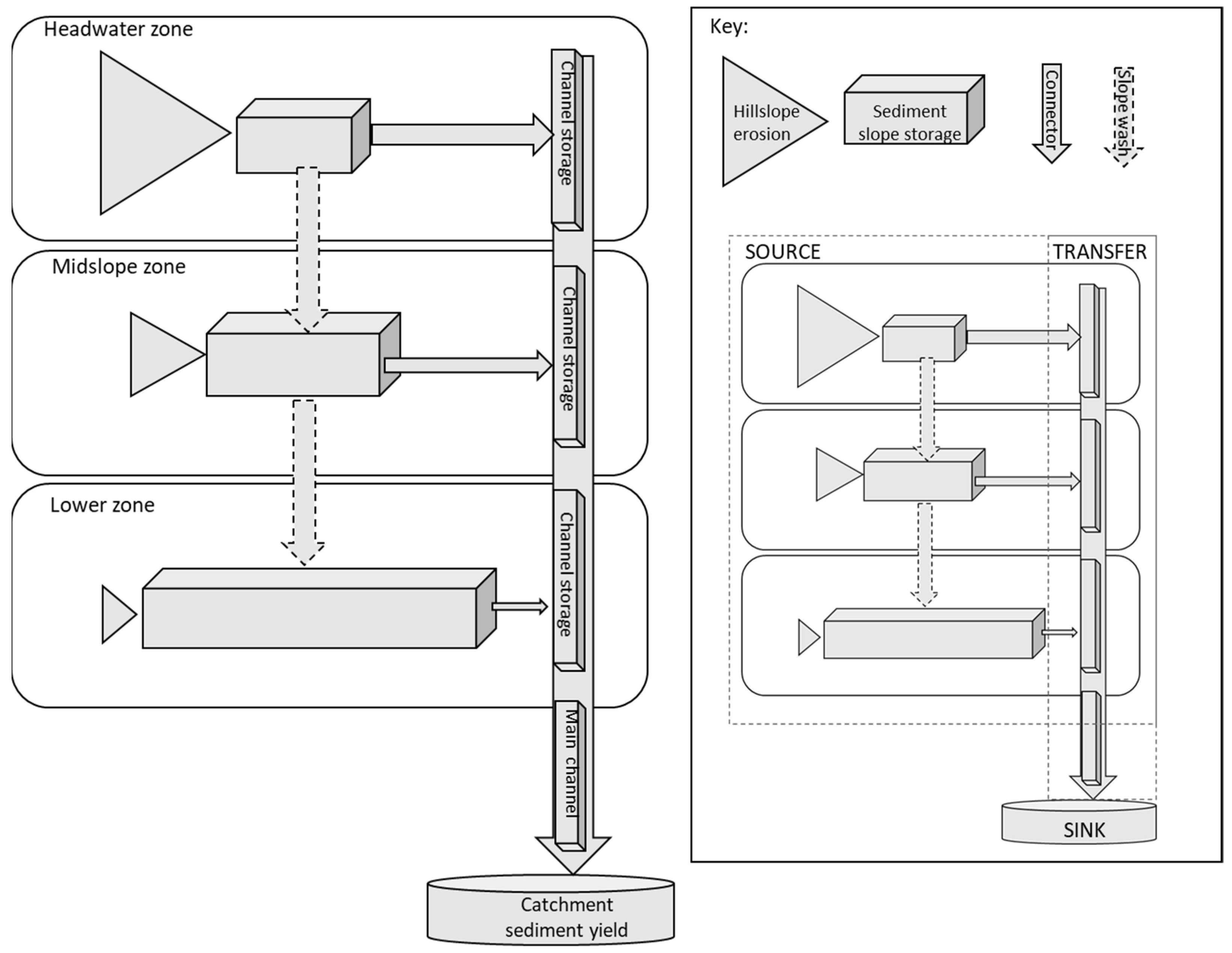

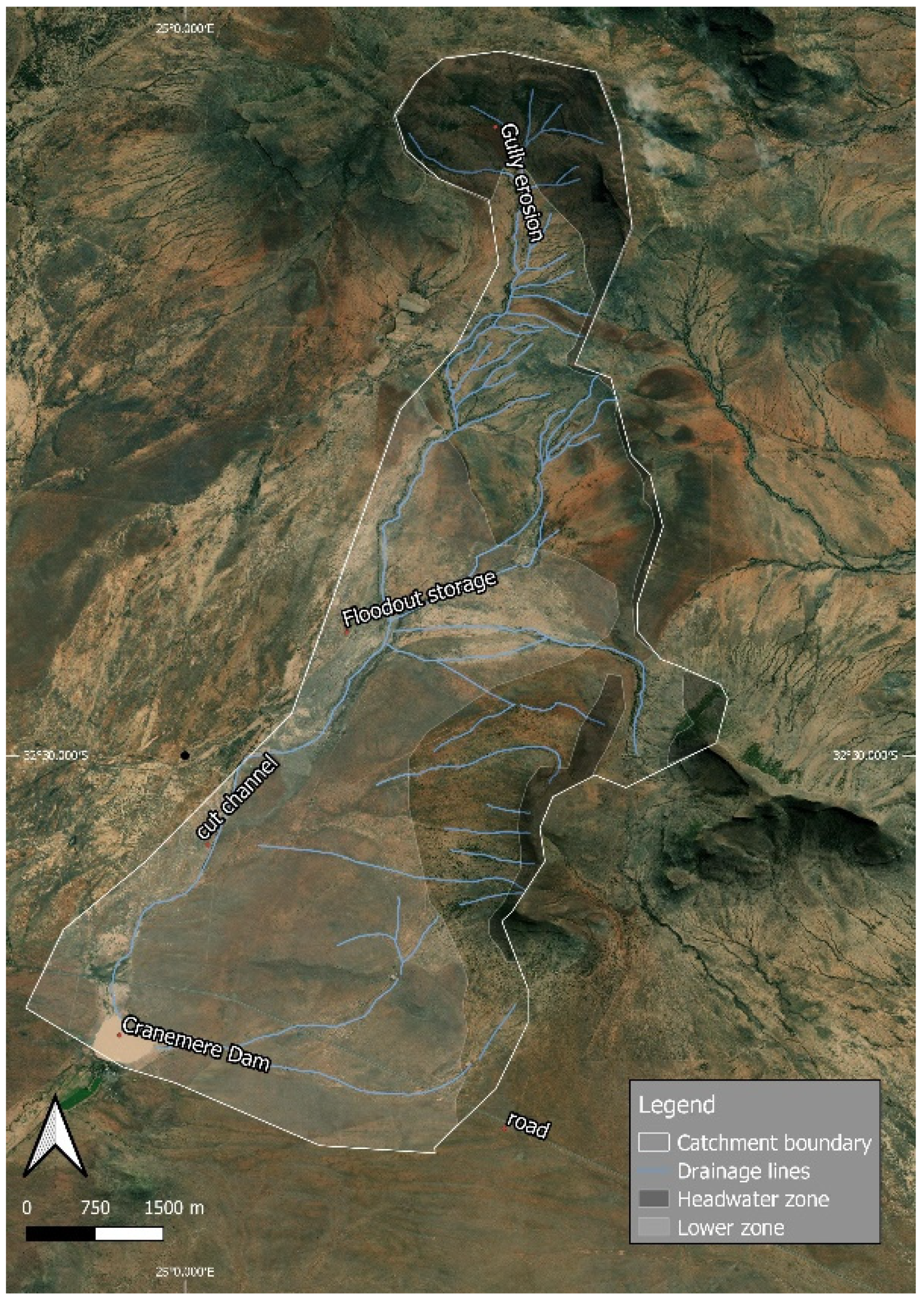
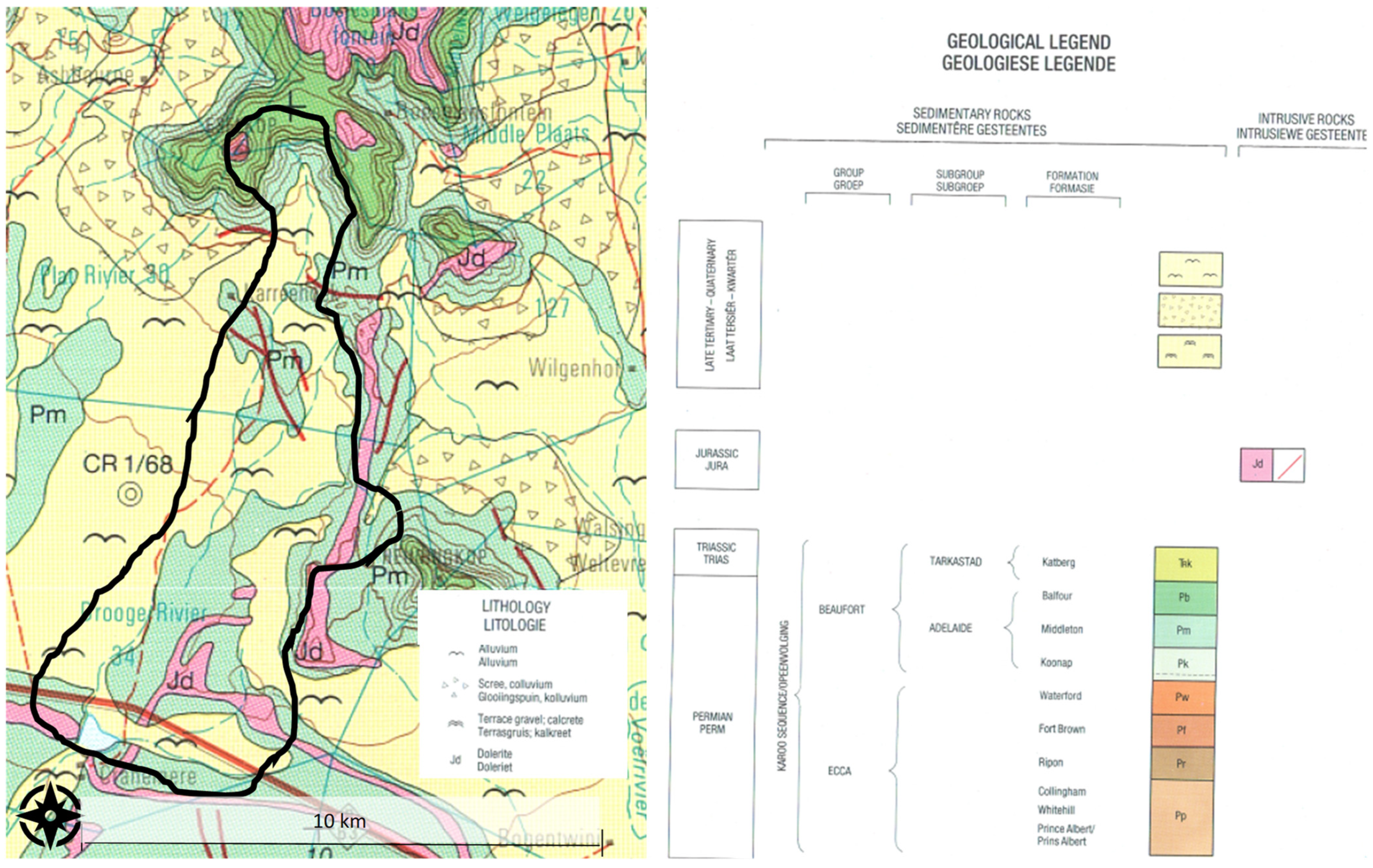
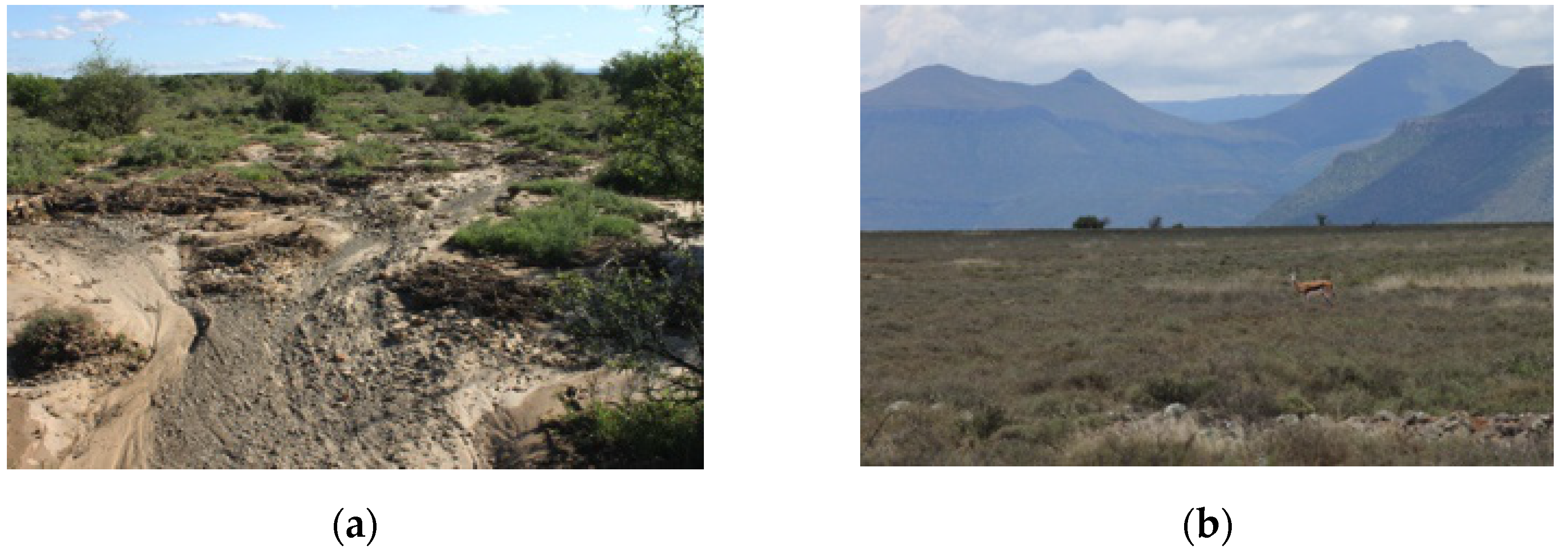

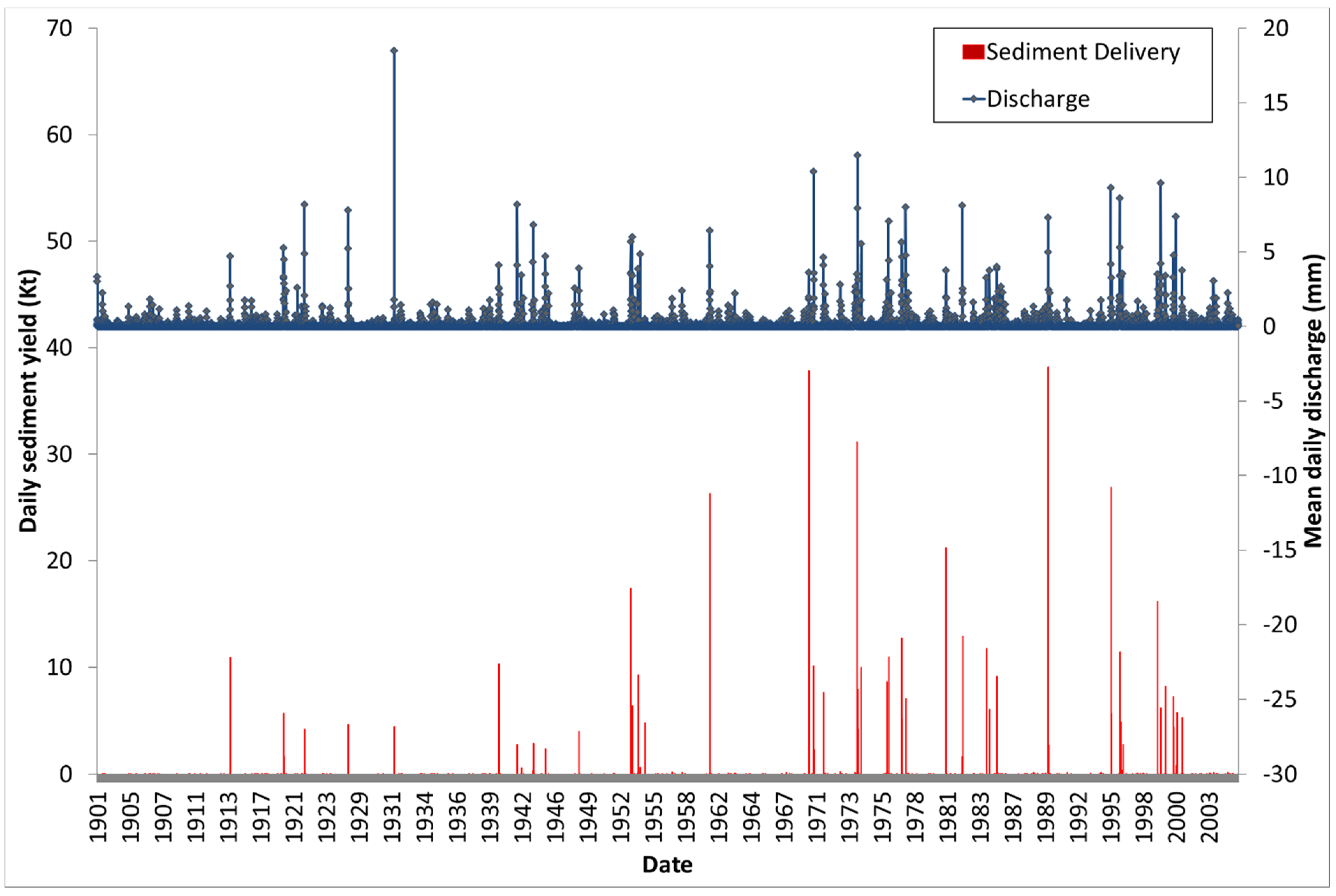
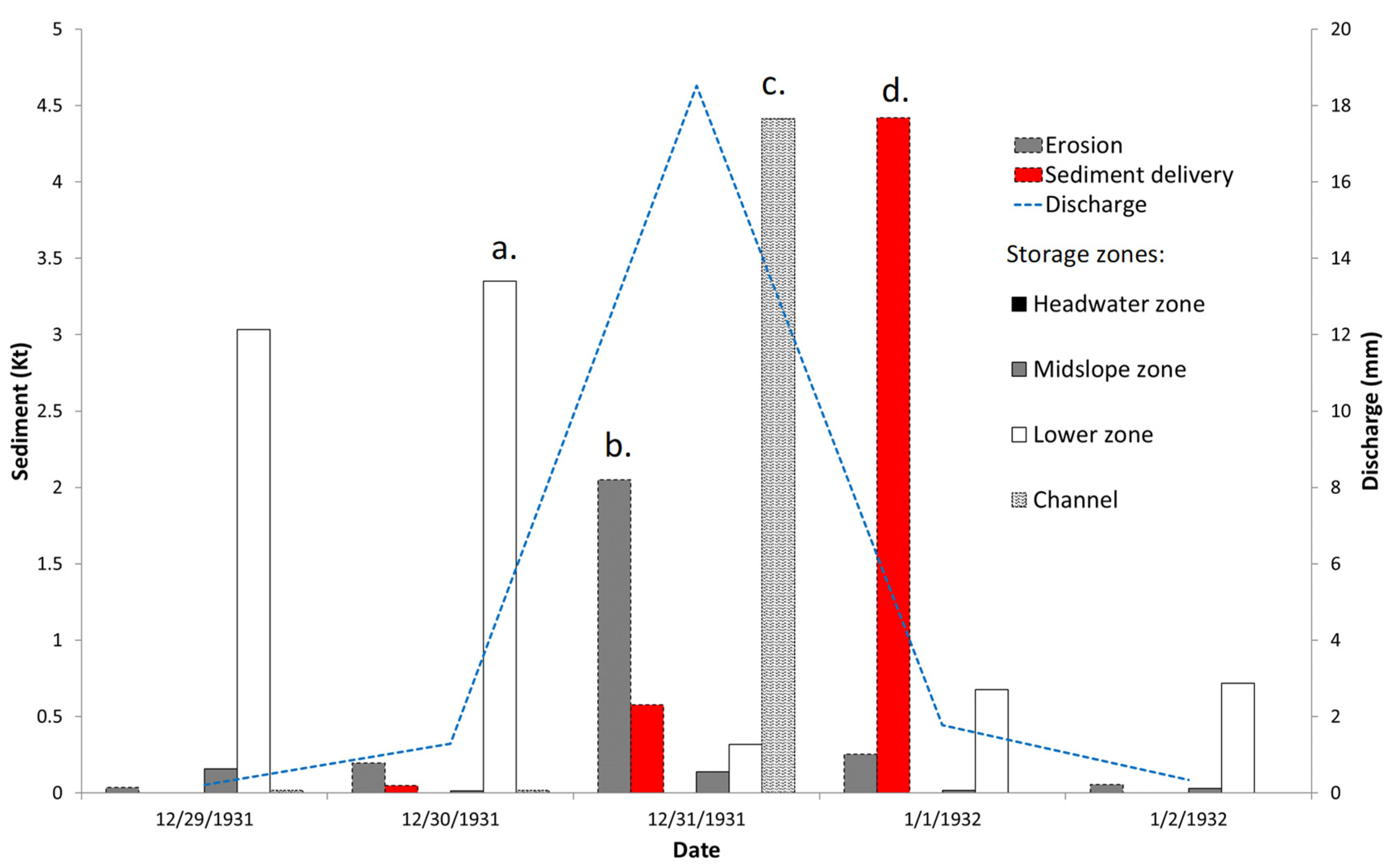
| Area (km2) | Elevation (masl) | Drainage Density (km/km2) | Max Potential Sediment Storage (Kt) | |||
|---|---|---|---|---|---|---|
| Headwater | Mid-Slope | Lower Slopes | Channel | |||
| 57 | 753–1507 | 0.13 | 1500 | 13,500 | 138,000 | 110 |
| Scenario | Description | Results |
|---|---|---|
| 1 | No parameter changes | Rainfall was an important driver for the observed increase in sediment yield in the latter half of the century but did not explain all of this increase. Other variables will also be important. |
| 2 | Decrease in vegetation cover after 1970 | Changing the vegetation cover impacts directly on erosion estimates, which were overestimated, with a n increase in sediment delivery, but modelled sediment yields underestimated observed rate. |
| 3 | Increase in landscape connectivity after 1970 | Increased connectivity meant that there were more sediment delivery events and an improved correlation with the observed sediment yield. |
| Scenario 1 | Scenario 2 | Scenario 3 | ||||
|---|---|---|---|---|---|---|
| Pre-1970 | Post-1970 | Pre-1970 | Post-1970 | Pre-1970 | Post-1970 | |
| Cumulative modelled erosion (t.km2) | 4000 | 10,000 | 5500 | 13,000 | 3000 | 10,000 |
| Cumulative modelled sediment yield (t.km2) | 2000 | 3500 | 2000 | 4000 | 4000 | 10,000 |
| Cumulative observed sediment yield (t.km2) | 2000 | 10,000 | 2000 | 10,000 | 2000 | 10,000 |
Publisher’s Note: MDPI stays neutral with regard to jurisdictional claims in published maps and institutional affiliations. |
© 2021 by the authors. Licensee MDPI, Basel, Switzerland. This article is an open access article distributed under the terms and conditions of the Creative Commons Attribution (CC BY) license (https://creativecommons.org/licenses/by/4.0/).
Share and Cite
Lodenkemper, L.; Rowntree, K.; Hughes, D.; Slaughter, A. Integrating Sediment (dis)Connectivity into a Sediment Yield Model for Semi-Arid Catchments. Land 2021, 10, 1204. https://doi.org/10.3390/land10111204
Lodenkemper L, Rowntree K, Hughes D, Slaughter A. Integrating Sediment (dis)Connectivity into a Sediment Yield Model for Semi-Arid Catchments. Land. 2021; 10(11):1204. https://doi.org/10.3390/land10111204
Chicago/Turabian StyleLodenkemper, Louise, Kate Rowntree, Denis Hughes, and Andrew Slaughter. 2021. "Integrating Sediment (dis)Connectivity into a Sediment Yield Model for Semi-Arid Catchments" Land 10, no. 11: 1204. https://doi.org/10.3390/land10111204
APA StyleLodenkemper, L., Rowntree, K., Hughes, D., & Slaughter, A. (2021). Integrating Sediment (dis)Connectivity into a Sediment Yield Model for Semi-Arid Catchments. Land, 10(11), 1204. https://doi.org/10.3390/land10111204





